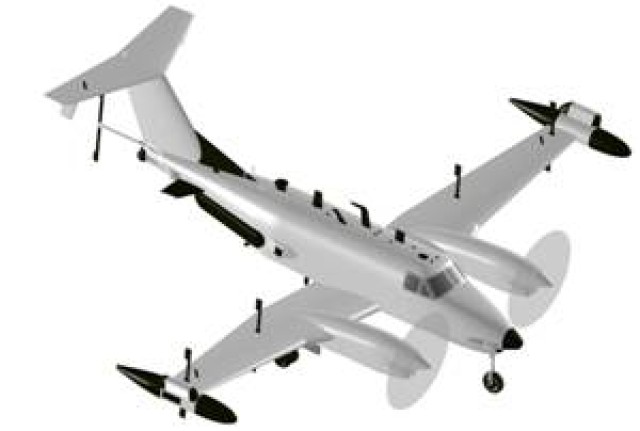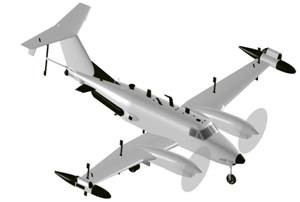Receiving signals intelligence (SIGINT) and targeting information in as close to real time as possible are essential factors in enabling information dominance and force superiority on the battlefield.
Modernizing the Guardrail Common Sensor (GR/CS) system is a critical aspect of equipping Warfighters with the capabilities they need to overwhelm enemy forces in theater. The CECOM Life Cycle Management Command's Software Engineering Center (SEC) plays a key role in modernizing and enhancing Guardrail, among the most advanced and accurate SIGINT platforms in operation.
The Guardrail system uses remotely controlled, fixed-wing RC-12 aircraft to intercept, identify, classify and determine the source and location of hostile communications and radio signals. The typical Guardrail system deployed to a battalion includes eight-to-12 aircraft that fly operational missions in sets of two or three.
The aircraft, which contain specialized electronics packages, simultaneously collect emitter transmissions with time and location data, and then transmit that data via satellite to an integrated processing facility (IPF) ground station in a secure area in the U.S., Germany or Korea. The raw data is then processed into actionable intelligence, which is then sent back via satellite through either the aircraft or a remote relay facility, ultimately reaching a tactical operations center for use in targeting and battle command decisions.
SEC personnel involved with Guardrail modernization have made invaluable contributions to the Army's strategic imperatives to prepare, reset, transform and sustain Warfighters and the resources that support them and their missions.
Most recently, during a Guardrail unit's reset period at Fort Hood, Texas, SEC staff meticulously documented and analyzed all of the software trouble reports recorded during the unit's deployment to Iraq. During the reset operation, the SEC team implemented important systems enhancements, including:
-- Increasing mission-operation communications capabilities between airborne relay facilities and ground stations by improving related software stability and performance. --- Developing an easy-to-use "knowledge data base" tool that greatly simplified the process used by Guardrail personnel to identify defective line-replaceable units (LRUs). LRUs are complex components housed in "black boxes" designed to be easily and quickly replaced using simple connections.
-- Reducing pre-flight checklist times by improving pre-mission processes.
-- Dramatically accelerating the post-operation evaluation process, reducing a three-to-four hour process to approximately 30 minutes.
In addition to supporting the airborne platform and the IPF ground systems software, SEC personnel provide systems integration support to reduce Guardrail's massive hardware footprint. The multiple large IPF trailers previously required are being replaced by streamlined and standardized Guardrail Ground Baseline (GGB) components that also feature improved SIGINT capabilities.
As a result, Guardrail units are able to deploy their aircraft without having to deploy extensive ground station components unrelated to their mission. The new GGBs also represent an important step in transitioning these components into the Distributed Common Ground System - Army, establishing a net-centric architecture for collaborative intelligence operations.
The Army's four Guardrail systems, which are all in the process of migrating to a common software and hardware baseline, are operated by Military Intelligence Battalions under the direction of the U.S. Army Intelligence and Security Command. They are:
-- 15th Military Intelligence Battalion - III Corps, Fort Hood Texas - deployed in support of OIF.
-- 1st Military Intelligence Battalion - V Corps, Wiesbaden Germany - deployed in support of OIF and Operation Enduring Freedom.
-- 224th Military Intelligence Battalion - XVIII Corps, Hunter Army Airfield, Savannah Ga. - deployed in support of Operation Iraqi Freedom.
-- 3rd Military Intelligence Battalion - 501st MI Brigade, Pyongtaek, Republic of Korea.
SEC helps prepare Warfighters by delivering the advanced SIGINT and targeting technology needed to fight ever-evolving enemy forces, ensuring information dominance and superiority on the battlefield.
By being actively involved in the reset process for returning Soldiers, the SEC provides numerous software enhancements and improvements in the Guardrail system, sustaining the life expectancy and value of the system. Supporting system integration efforts to dramatically reduce ground-station footprint size transforms and modernizes Guardrail technology and streamlines the system's deployment.
The Army's prepare, reset, transform and sustain framework is designed to restore the balance between the demands placed on Warfighters. The SEC contributions to the Guardrail system demonstrate SEC involvement in key aspects of these strategic Army initiatives.
(Eddy Hitti is the Director for Intelligence, Surveillance, Reconnaissance Software at the Software Engineering Center, CECOM. He holds a Master of Science in Software Engineering from Monmouth University, a Master of Science in Electrical Engineering from Southern Illinois University Edwardsville and a Bachelor of Science in Computer Engineering from the University of Illinois at Urbana-Champaign.)


Social Sharing